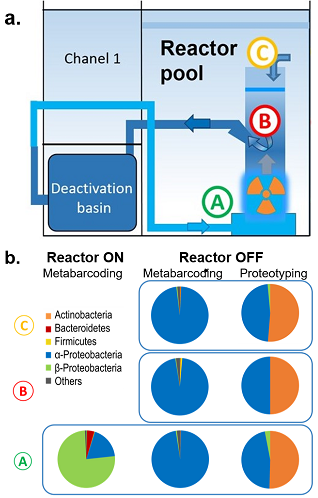The pools of nuclear reactor facilities are environments hostile to life, bathed in ionizing radiation, filled with demineralized water and containing toxic radioactive elements. Due to access restrictions and high handling constraints related to the high level of radioactivity, very little is known about life in these environments. As for the water circuits that directly cool the cores of nuclear reactors, the constraints and the level of radioactivity are so extreme that life has never been searched for there. Previous investigations by the team and other groups have already revealed the presence of microalgae and bacteria in waste fuel storage pools, but the levels of radioactivity were much lower.
In this work, researchers have, for the very first time, investigated the possibility of finding living organisms in the radioactive water used to cool the core of an operating nuclear reactor, the French research Osiris reactor, an open-core reactor immersed in an 11-meter deep pool, permanently shut down in 2015. For this purpose, they took water samples at several points in the pool, both during the operation of the reactor and when it was shut down. Two direct meta-omic approaches, namely DNA metabarcoding and proteotyping, were used. They are respectively based on 16S ribosomal RNA gene sequencing and on peptide analysis by mass spectrometry.
Researchers have thus identified 25 microbial genera in the radioactive water of the heart pool during the functioning of Osiris and, more precisely, the predominant genera Variovorax and Sphingomonas. These genera were supplanted by Methylobacterium, Asanoa and Streptomyces after the shutdown of the reactor.
The presence of an abundant strain of Variovorax could be linked to its ability to use the dihydrogen produced in huge quantities by the radiolysis of water during the reactor's operating cycle. In addition, Variovorax has multiple resistance factors to metals as well as to oxidative stress which would allow it to overcome radiative and metallic stress.

Figure: a. Diagram of the cooling circuit of the Osiris reactor, with the different points (A, B, C) for taking water samples for microbial analyses. b. Bacterial species identified in the reactor water during operation and shutdown according to the 2 meta-omic methods.
Against all odds, these results show that life is indeed present in the cooling water of an operational nuclear reactor, albeit with a very limited number of bacteria, such as Variovorax. They open perspectives in the discovery of new radioresistant species and in the understanding of radiotolerance mechanisms that could be exploited in medicine or bioremediation.
Contact Joliot/I2BC : Corinne Rivasseau
News adapted from the Micro News of the I2BC Microbiology Department.